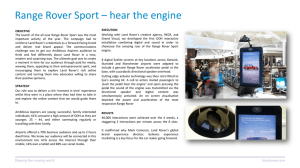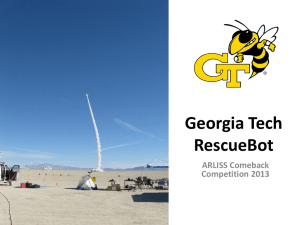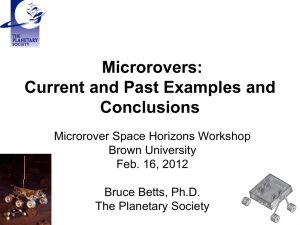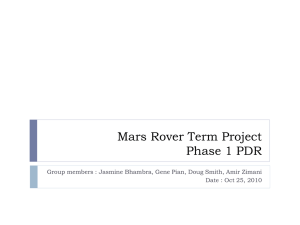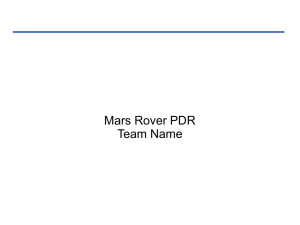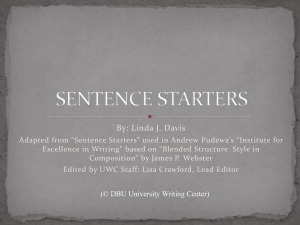SEEC Presentation
advertisement
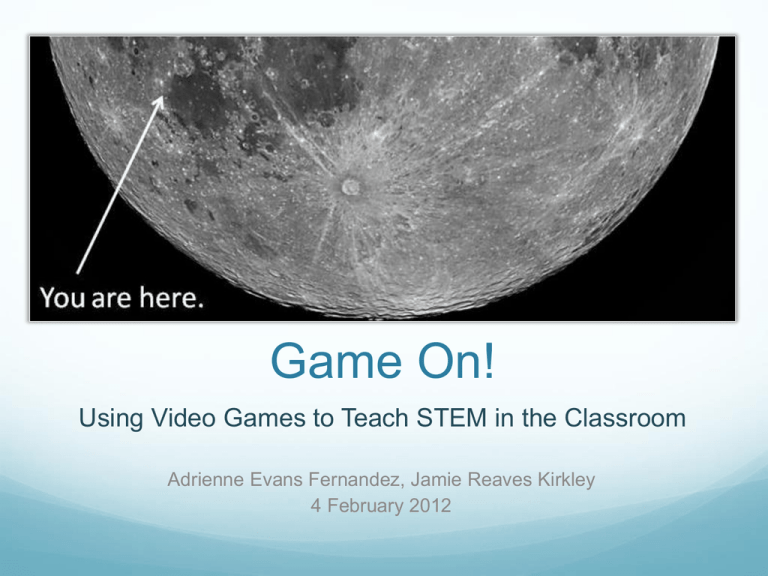
Game On! Using Video Games to Teach STEM in the Classroom Adrienne Evans Fernandez, Jamie Reaves Kirkley 4 February 2012 Agenda Introductions Games as teaching tools Overview of the field Getting support from stakeholders AstroEngineer: Moon Rover (AEMR) Review games and learning Overview of AstroEngineer game Review the AEMR Teacher’s Guide Explore a demo of the game Who Are We….. WisdomTools, Inc. creates serious games and elearning solutions for education and training Use entertainment game approaches that engage and teach; game mapped to objectives and standards Focus on STEM-focused games that teach difficult concepts in science, technology, engineering and mathematics AstroEngineer: Moon Rover (released Aug 2010) AeroEngineer: Race to Mars (TBR Aug 2012) NanoMech (TBR Fall 2012) The Challenge of STEM (Science, Math, Engineering & Mathematics) U.S. is not able to fill STEM-related job positions due to lack of STEM graduates Many students lose interest in STEM-related courses at the middle and high school levels Minority and female students are more likely to discontinue taking STEM related courses (National Center for Education Statistics, 2005) Minorities are underrepresented in high-level science, technology, engineering and math occupations (Leslie, 1998) Serious Games Serious games (a subset of computer educational games) seen as a way to engage students in STEM Federation of American Scientists, Gates and MacArthur Foundations, Woodrow Wilson Institute, etc. etc. White House office examining educational benefits of video games:http://www.usatoday.com/news/washington/story/201201-26/edcuational-video-games-white-house/52908052/1 Advantages of Using Serious Games in STEM Take students to space!! Reach students on their own terms; research shows they play HOURS of video games at home each week Playing games motivates students, and motivated students learn more Build student interest, engagement & learning in STEM Teach concepts not possible in real life (i.e., dangerous) Support inquiry-based learning Combine with hands-on and other types of activities Use games as part of project and problem based learning curricula Serious Games & Learning Serious games can facilitate: Building interest and learning STEM content/careers “Strategic thinking, problem solving, plan formulation and execution, and adaptation to rapid change” (Federation of American Scientists, 2006) Players are given opportunities for challenge, strategy and problem-solving (Lazzaro, 2004). Well-designed games can support: Problem solving & decision making (Adams, 2006; Gee, 2003; Taradi, Taradi, Radic & Pokrajac, 2005) Active learning (Winn, 2008) and creativity Complex systems thinking and literacies (Steinkuhler, 2008) Experiments, inventions, & learning by doing (Rickard & Oblinger, 2004) Team-based challenges/collaboration (Bourgonjon, 2008) Creativity (Jackson et al, 2011) Serious Games & PBL Games more effective when embedded in instructional program that includes feedback and debriefing (Hays, 2006) Researchers have promoted the use of digital games within problem based learning environments (Annetta, Cook & Schultz, 2007; Kiili, 2005; Maxwell et al, 2004) Natural ties between PBL and games (Annetta, Cook & Schultz, 2007; Kiili, 2005; Maxwell et al, 2004) Both are learner centered Both provide authentic challenges to solve Both often require collaboration, negotiation, and problem solving Disadvantages of Games Implementation: Technical support Learning and curriculum Integration Clarity of objectives/standards met Monitoring learning and assessment Assessment and monitoring of student learning Debriefing and student report outs Achievement of learning outcomes Buy in from admin, parents and IT Using games in ways that do not support effective STEM learning: Game as reward only Game as entertainment only Babysitting tool Little or no facilitation of learning in classroom Games As Teaching Tools History of using games to support learning Oregon Trail, SimCity, Math Blaster Current games and virtual worlds River City, Wolfquest, Selene, Supercharged!, Whyville.net, WhyReef, Quest Atlantis, Eco MUVE, Electrical Endeavors Similarities and differences between simulations, games & virtual worlds Sims: First person, focus on realism/fidelity, algorithmic formula with time and conditions as variables Games: Provide rewards, entertainment, learn by failure Virtual Worlds: Persistent world, interactive community Tips for Gaining Buy In To get buy in from administrators and parents: Write brief letter or newsletter article on the specific game and how it’s being used to support STEM learning in your classroom Provide information on learning outcomes and provide images To get buy in from IT: Provide information on technical requirements Have a back up plan in case Internet goes down! AstroEngineer: Moon Rover AstroEngineer: Moon Rover AstroEngineer: Moon Rover is an educational video game created to introduce middle school students to the engineering design process. Developed in partnership with Project Lead the Way (PLTW), a non profit that provides middle and high engineering curriculum to schools in all 50 states ™ Project Lead the Way PLTW approached us in 2009 to form a partnership. Gateway to Technology: Middle school engineering curriculum Wanted a product that required students to design solutions to a problem and reinforce the cyclic steps of the engineering design process. You do NOT have to be affiliated with PLTW to use AstroEngineer: Moon Rover! Engineering Design Process Game play focuses on use of the engineering design process to : Analyze mission requirements and key design criteria/constraints for an unmanned lunar rover Design your rover to meet mission requirements by choosing among various parts (e.g., body type, wheel type, power source, and sensors) Test your rover by driving it on an authentic lunar surface and under realistic conditions Redesign your rover until the mission is successful and then move on to the next mission Background of Game Set 30 years in the future, the player is aboard the Goliath, a manned lunar mobile base stationed near the Mare Humorum Core challenge in the game is design, test, and redesign a lunar rover based on specific engineering design criteria and constraints. Players design smaller rovers; confronted with authentic lunar terrain, hazards, and environmental conditions Overall Mission Game Design The game itself consists of five sets of missions (a tutorial, three regular missions, and a rescue mission) Each mission is comprised of 4 to 5 legs, each with a different goal. Speed Durability Collection of samples Each leg will require a different configuration of parts in order to be successful! Rover Construction Area Test Your Rover Design Mission Feedback Screen AstroEngineer Leaderboard AEMR Problem-Centered Curriculum Unit Week long teaching unit with: Game Introduction and Overall Challenge (10 min) How can the different design choices that you make impact your rover ’s performance? What factors influence the design choices that you make? What strategies can you use to improve your rover design? Game Play (25 min) Debriefing (15 min) What was the core mission today? What design criteria you were given? What design constraints did you encounter? How did you optimize your design? Classroom Implementation In a traditional 50 minute period students are expected to complete about 1 mission per day On block schedules students can complete 23 missions per day. Scientifically Authentic Authentic Lunar Geography NASA Images Vocabulary Engineering process Includes Earth and Space science objectives, including Characteristics of the Lunar environment Topographical characteristics and vocabulary (regolith, rilles, mares, etc.) Specific locations and structures the game visits (craters, rimae, etc.) Common elements and minerals found on the moon As close as we could get.. Design Simplifications: Rover Parts & Capabilities (middle school audience) Speeds Pushing the Envelope…! Presence of Ice on the Moon? Research Findings Research funded, in part, by NSF Pre/post quasi-experimental study conducted with 341 middle school students (~equal number of males/females; racially diverse population) Females = 54.4% of sample Males = 45.6% of sample Students played for ~2 hours (113 minutes) over one week period, or 45.2% of overall class time; does not include game introduction and debriefing sessions Research Findings Analysis of variance (ANOVA) was conducted to examine pre/post differences Results indicated statistically significant differences in learning between the pre- and post-test (F [1, 681] = 475.135, p < .001, partial eta-squared = .411), with higher scores on the post-test Both male and female students provided positive feedback on the game’s design, ease of use, and graphics Supporting Educators AstroEngineer: Moon Rover™ includes curriculum support Teacher Guide Student Guide FAQs Lesson plans Enrichment activities The Teacher’s Guide AstroEngineer: Moon Rover includes documents to help you and your students get the most out of the game The guide includes Basic instructional and narrative overview Learning objectives The Teacher’s Guide Getting started FAQ Controls and parts overview for teachers Mission flow charts The Teacher’s Guide Standards Alignment ITEEA NSES NSTA Glossary General Moon Terms Engineering Terms Description of Parts Student Guide Includes Game Overview Getting Started Tips Engineering design steps Glossary Supplemental Activities Sometimes the internet goes down. MINI Card Game! Extension Opportunities Additional activities that can extend the AstroEngineer: Moon Rover game out of the computer lab. Tires for the Moon Cost Analysis Activities Release of AEMR AstroEngineer was released in August 2010 to over 6000 PTLW teachers and 60,000 students, as well as 2500 students in Indiana’s NASA IGNITE STEM program AstroEngineer can now be purchased and downloaded from: http://space.wisdomtools.com Let’s Play! Installation When you get your drive, insert it into your USB port Select which version you want to install (MAC or PC) and drag the file to your desktop. PLEASE NOTE: You cannot run it from the drive! Double click to unzip (if needed), and have fun! Questions? Contact us! http://www.wisdomtools.com Adrienne Evans Fernandez Lead Content and Curriculum Game Designer adrienne@wisdomtools.com Jamie Kirkley Chief Learning Officer, Senior Instructional Designer jamie@wisdomtools.com AeroEngineer: Race to Mars Serious game with five game modules and week-long curriculum unit designed to interest and teach high school students (10th - 12th grade), particularly females, about core aerospace engineering concepts

